HALF PRICE SALE ENDS AT MIDNIGHT TONIGHT
***TODAY ONLY – GET AN EXTRA 10% OFF SALE PRICES WITH CODE FLASH10***
Menu
HALF PRICE SALE ENDS AT MIDNIGHT TONIGHT
***TODAY ONLY – GET AN EXTRA 10% OFF SALE PRICES WITH CODE FLASH10***
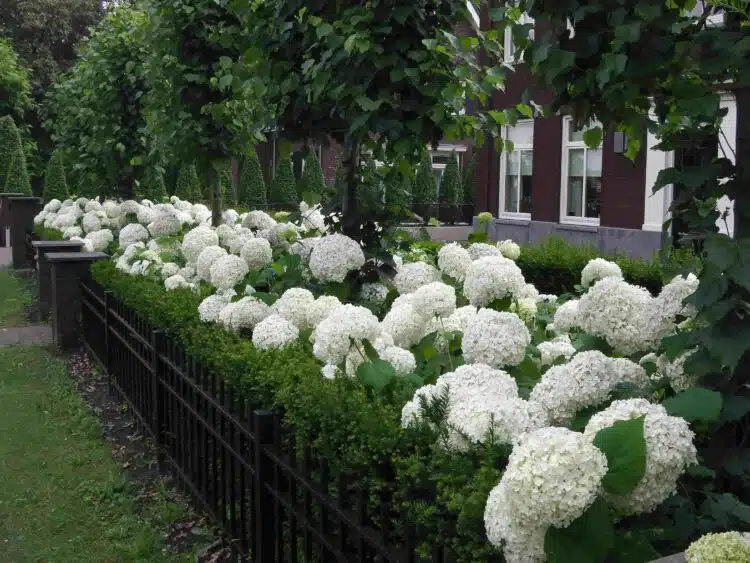 https://www.hopesgrovenurseries.co.uk/wp-content/uploads/2024/02/hydrangea-annabelle-2-750x563.jpg
a flower filled hedge
https://www.hopesgrovenurseries.co.uk/wp-content/uploads/2024/02/hydrangea-annabelle-2-750x563.jpg
a flower filled hedge
Hedges are a vital part of any good garden. On the practical side they screen those less-than-lovely, but totally necessary, areas like the compost heap! They cast shade and offer shelter and this helps to protect nearby plants from strong overhead sunshine, or searing winds. Their roots drain the soil as well and our erratic climate is becoming far more stressful, so their protective presence is needed more than ever. They also form visual full stops: they can lead the eye along a vista, or create a surprise around the next corner.
We tend to think of hedges as being leafy and green, but there are plenty of hedging plants that produce flower as well. One of the prettiest and subtlest is Abelia x grandiflora. The underused semi-evergreen has glossy foliage and a naturally branching shape so it provides a handsome presence in winter. This hybrid abelia will flourish in most garden soils, with the exception of very dry. Abelias will tolerate some shade too, so they’re good on a woodland edge. It’s also hardier than many give it credit for, as long as it isn’t exposed to cold easterly winds or wet winter roots.
There are various named forms with colourful foliage and these tend to be more compact, reaching just a metre or so in height or 39 inches. The compact ‘Confetti’ has small grey-green leaves margined in pale-cream, so it’s well-named. However, the foliage becomes infused in pink once temperatures drop, so it colours up late in the year. The warm-white, tubular flowers open from midsummer until mid-autumn and they’re framed by plenty of foliage. ‘Kaleidoscope’ is a similar height, but the foliage has a mixture of red, green and gold so this is brasher.

Abelia flowers are always held in a cluster of red calices and these persist long after the flowers have faded, providing an autumnal tinge of red. ‘Sunny Charms’ is the first yellow-flowered form, although there are still pink overtones due to those almost-everlasting calices. It’s a little ‘rhubarb and custard’, but don’t let that put you off. If you’re after more height, opt for the glossily green A. x grandiflora, which will reach up to 2.5m, or 8ft, in time. The foliage and flowers of all abelias cut well too.
Abelias are modest growers, so it’s an easy hedge to maintain and best planted in sheltered, slightly shady areas. If you want plenty of flower, trim or prune in early spring, so that you encourage flower buds to form before summer. If you prefer to major on foliage and form, trim back throughout the growing season. Variegated and colourful abelias can revert to green, so if you spot an all-green shoot, you must remove it straight away.
If you want an early-flowering, deciduous hedge for April and May the flowering currant or Ribes sanguineum provides the perfect screen for a spring garden or a boundary edge. It’s tough, resilient and reliable and it will grow in a range of soils, as long as there is no waterlogging in winter. The cascading, downward-facing flowers are very insect-friendly. The foliage has a distinctive currant aroma, admittedly, but it’s so trouble-free it’s well worth planting.
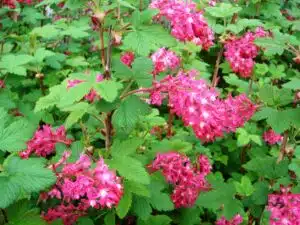
‘King Edward VII’ has red-crimson flowers that stand out from the newly-emerged bright-green foliage. The upright habit calls for close planting. Three per metre is recommended, and container-grown plants romp away faster than bare root. ‘Somerset White’ will look at its best in a shadier position and you can shake any browned flowers away after they fade. Prune after flowering to create a denser, twiggier habit, although the flowering currant will happily thrive without any maintenance at all. It will attain five or six feet in height (up to 2m) and form a five-foot wide (1.5m) barrier. It will look bare in winter, however.
Mock orange, or philadelphus, sends a waft of citrus scent through the garden in midsummer just as the white flowers open in June and July. Fragrance intensifies as evening descends, so this is one of most fragrant plants for a summer garden. You can also grow philadelphias as single specimens and the fact that they flower after the roses makes then very useful succession plants. They plug the gap between flushes of repeat-flowering roses and their gentle colouring blends with the pastel palette of summer herbaceous.
The clean-white flowers sometimes have a deep plummy blotch in the middle and this softens the flowers. The award-winning ‘Belle Etoile’, one of the most fragrant and floriferous of all, displays a pronounced mauve blotch set round a yellow boss of stamens. ‘Belle Etoile’ will form a deciduous hedge reaching up to 5ft, or 1.5m. ‘Aurea’ is a golden-leafed mock orange, best grown in slight shade to avoid leaf scorching.
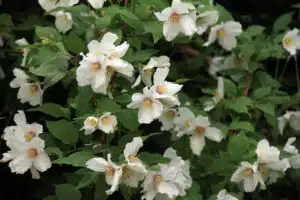
The leaves of ‘Aurea’ fade to pale-green in summer, but the new spring foliage is spectacular, especially when rising above sultry tulips or the orange-topped spurge, Euphorbia griffithii ‘Dixter. It’s just as free-flowering, but there are no purple blotches on the flowers. The long stamens, within the open white flowers, are very attractive though. The slightly taller ‘Starbright’ produces much larger all-white flowers and the new foliage and stems have a purple tinge. The open four-petalled flowers are rather clematis-like and the flowers tend to be towards the top of each stem.
When it comes to pruning mock orange, or philadelphus, they produce flower buds on new growth so some of the older stems need removing. It’s traditional to remove one third of the old stems after flowering each year. The older stems are a darker, duller colour. However, you can prune mock oranges biennially, that is every other year, straight after flowering. Some gardeners remove entire stems from the base, but the rule of thumb is to only take out one in five of the stems. Plant 3 per metre if you’re developing a hedge.
Mock oranges are closely related to hydrangeas. These became separated by continental drift millions of years ago and developed differently. American hydrangeas are hardier and more tolerant of conditions than Asian ones because they’ve evolved in the heart of America. Winters are cold and snowy and summers, hot and humid.
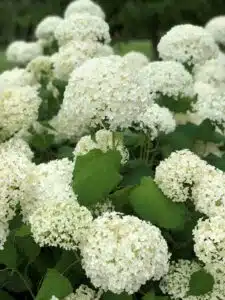
Hydrangea arborescens ‘Annabelle’ was found near the town of Anna in Ohio, reputedly by a lady called Bella who was out riding her horse. It’s hardier and easier to grow than most Asian hydrangeas and it will give months of interest. In midsummer the newly formed buds are a zingy lime-green and then the flowers open to produce a cream-white dome. The flowers fade back to green and develop rose-pink tinges as they fade. They cut and dry well at all stages. It’s a good idea to remove the faded heads as winter approaches, because the papery florets break up and that makes for extra work!
When left to its own devices (and grown as a hedge) the flowers of ‘Annabelle’ measure a handspan or more. If you cut it down hard, they can be a foot across but you won’t get as many flowers. It’s horses for courses. Height varies accordingly, but in good growing areas, where summers are wet and warm, Annabelle can top 5 feet.
The peeling bark of H. arborescens is also attractive and the name sevenbark hydrangea refers to the shades of brown and beige on the papery stems. It’s a strong plant and it can cope with a box edging or it can fill a parterre. ‘Candybelle Bubblegum’ is a new mid-pink version of ‘Annabelle’ and ‘Marshmallow’, a paler salmon-pink. Hydrangea are best left to overwinter unpruned. Wait until the buds break in spring and then cut back to the highest bud tip, leaving as much stem as possible.
‘Annabelle’ will grow in bright shade or full sun, but if you want a later-flowering hydrangea – with same spring-zing and white colouring – Hydrangea paniculata ‘Limelight’ would make a perfect hedge or woodland specimen. The conical heads are graceful in form and not over-large. These late-summer hydrangeas are shade tolerant and they cope in drier soil. The name ‘Limelight’ is ideal, because they do light up shade, adding a cool infusion to late-summer day. They’re good in woodland borders that major in spring, because they add a late swansong.
Hardy fuchsias need the same ‘wait and see’ policy when it comes to pruning, because they can shoot high up the stems after a mild winter. Hardy fuchsias form good hedges if they’re planted in sheltered places out of full sun and cold winds. West is best and one of the most spectacular forms is ‘Mrs Popple’, a vision of rich-red and purple flowers.
‘Mrs Popple’ was discovered by nurseryman Clarence Elliott of Six Hills Nursery near Stevenage in Hertfordshire. It was before the Second World War and Clarence was at a tennis party being held in his neighbour Mrs Popple’s garden. He mistook it for a tender fuchsia, until the lady of the house explained that it stayed out all year. Very Betjeman, tennis and tea being held in an English country garden.
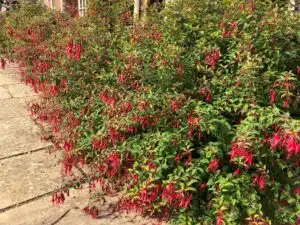
Two other fuchsia options are the lower growing golden-leaved ‘Genii’ and the slender-flowered ‘Ricartonii’. The latter has long wands bearing smaller flowers that are predominately red. In milder and damper areas of the country, such as the far west and the Isle of Anglesey, fuchsias will flower all year long. They will not enjoy cold spots!
Many of our customers buy topiary plants (and hedging plants) to grow in containers, one frequently asked question is how large does the pot that I plant them into need to be?
Expert horticultural advice on the merits and pitfalls of planting bare root yews, and how to get the best from them.
Pleached trees are a garden-design favourite, because they provide an instant leafy screen that looks stylish as soon as it’s planted. They offer privacy for you and they help to muffle noise and that’s becoming more important in our busy world. They provide a living screen that’s far more eco-friendly than a stark wooden fence…